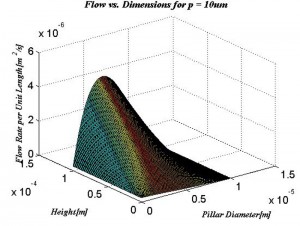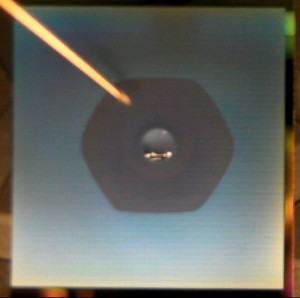Externally-fed, Microfabricated Electrospinning Device for Increased Throughput of Polymer Nanofibers
- Category: MEMS & BioMEMS
- Tags: frances hill, luis velasquez-garcia, philip ponce de leon
Electrospinning is a process in which a membrane-like web of thin fibers can be produced using high electrostatic fields and polar liquids with high viscosity. It is the only known technique that can generate continuous fibers with controlled morphology in the 10-500 nm diameter range and has tremendous versatility as it can create non-woven or well-aligned mats of polymer, ceramic, semiconductor, and/or metallic fibers using the same hardware. Electrospinning is also capable of conformally coating 3D complex shapes with ultrathin layers that have complex multi-layered structure and thickness variation across the surface. In particular, polymer electrospun fibers have been proposed to develop multi-stack functional fiber mats for protective gear, because they show high breathability, elasticity, and filtration efficiency. In addition, electrospun fibers made of the appropriate materials could also be used in flexible electronics (graphene) and in structural reinforcement against mechanical trauma. However, the production of electrospun nanofibers has very low throughput due to the small fiber diameter, which limits their applications to high-end products. In this project we are investigating the development of high-throughput electrospun nanofibers using batch-microfabricated arrays of externally fed electrospinning emitters. Externally-fed emitters are attractive, because they do not require high pressure drops as internally-fed emitters do. Also, they do not clog and can process liquids that bubble.
An aspect of this project is looking into the physics of wicking to optimize the fluidic micro/nanostructures that control the emitter flow rate. For solids with intrinsic contact angles below some critical value determined by roughness geometry, it becomes energetically favorable for a droplet to completely impregnate the roughness and spread through it [1] . This process of hemi-wicking has been described in pillar arrays of varying shapes and sizes [2] [3] . For externally-fed electrospinning, we must ensure a sufficient and steady flow rate of polymer solution to avoid broken or irregular fibers. We are theoretically and experimentally investigating optimal morphologies of both the micro/nano fluid control structures and the emitter geometry to attain good array emission uniformity.
- Figure 1: Fluid diffusion rate as a function of micropillar height and diameter for a fixed pitch of 10 µm. At constant height, there exists some intermediate diameter where the flow is maximized.
- Figure 2: Photograph of fluid being transported through the micropillar patterned surface. Several different spreading regimes can be achieved by varying micropillar geometry.
- D. Quéré, “Wetting and roughness,” Annu. Rev. Mater. Res., vol. 38, pp. 71-99, April 2008. [↩]
- L. Courbin, J. C. Bird, M. Reyssat, and H. A. Stone, “Dynamics of wetting: From inertial spreading to viscous imbibition,” Journal of Physics: Condensed Matter, vol. 21, p. 464127, 2009. [↩]
- C. Ishino, M. Reyssat, E. Reyssat, K. Okumura, and D. Quéré, “Wicking within forests of micropillars,” Europhys. Lett., vol. 79, p. 56005, 2007. [↩]

